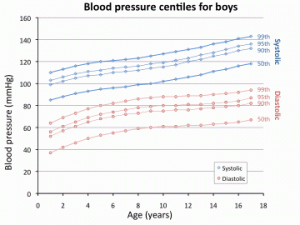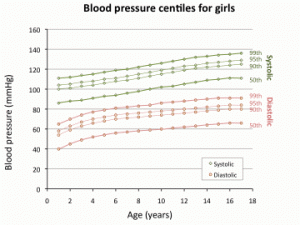Blood pressure measurements tend to be omitted in routine assessments of children. When it is measured, the variation of normal BP with age can lead to missing the diagnosis of hypertension. Normal ranges are shown below. Taller children have slightly higher average BPs. Centile values shown are for 50th height centile: average BPs vary by ±3-5mmHg for 5th-95th height centiles (so range typically varies 6-10mmHg for height at any age).
The ESCAPE trial (2009) showed that controlling blood pressure to below the 50th centile was more effective than a target of 50-90th centile in reducing renal endpoints in 385 children with renal disease followed for 5 years (30% versus 42%). All were also treated with an ACE inhibitor. As in adults, proteinuria and lower GFR predicted higher risk of progression.
Blood pressure charts: The charts on this page were constructed from US data linked below. UK children’s blood pressures are slightly higher, particularly pre-pubertally, and we thought the US data already high enough (e.g. systolic 50th centile boys and girls aged 8 is about 107 in UK versus 99 in US; age 4, 101 vs 93. Age 16 boys 50th centile 116 US, 120 UK; girls 109 US, 106 UK. However differences are substantially smaller at upper centiles). Click to enlarge individual figures; download a pdf with larger charts for printing at foot of page.
 |
 |
The International Paediatric Hypertension Association categorises blood pressure into three stages. The value of doing this, rather than simply reporting the centile as you might for height or weight, isn’t certain:
- Prehypertensive = 90th centile to 120 mmHg
- Stage 1 hypertension = 95th centile upwards
- Stage 2 hypertension = 99th centile + 5mmHg
A UK recommendation is to consider anything over the 98th centile as hypertension, and 91-98th as high-normal.
Patient information
High blood pressure and kidney disease (in adults) from EdRenINFO
Acknowledgements: Neil Turner was the main author for this page. It was created in May 2010 and significantly revised in July 2010. The last amended date is shown in the footer.
